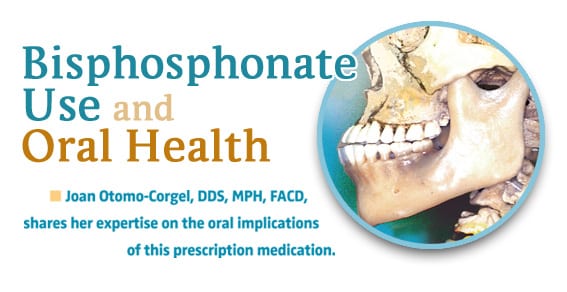
Bisphosphonate Use and Oral Health
Joan Otomo-Corgel, DDS, MPH, FACD, shares her expertise on the oral implications of this prescription medication.
Q. What is the concern about bisphosphonate usage in the dental patient?
A. Bisphosphonates are prescribed to treat osteoporosis/osteopenia; osteitis deformans (Paget’s disease); and reduce skeletal bone resorbtion and sequela secondary to multiple myeloma or metastatic solid tumors due to the treatment of breast, lung, and prostate cancers. The medication localizes to bone and specifically interferes with osteoclasts. There are currently more than 10 bisphosphonate agents with different potencies. Once monthly intravenous (IV) applications of zoledronate (Zometa) and pamidronate (Aredia) have been linked with recently diagnosed cases of jaw osteochemonecrosis.1 Oral medications such as alendronate (Fosamax) and risedronate (Actonel) currently have conflicting reports as to possible jaw bisphosphonate osteonecrosis. The concern in dentistry is the development of osteochemonecrosis following intraoral trauma, such as surgery or simple denture irritation, in a susceptible patient.
Q. What is osteonecrosis? What causes it?
A. This problem is termed bisphosphonate osteonecrosis, osteonecrosis of the jaw (ONJ), or osteochemonecrosis. Osteonecrosis is a disfiguring jaw condition that includes serious infection and osteopetrosis, an abnormal build up of fragile bone. Intraoral signs and symptoms include necrotic bone exposure, sequestration, and a chronic soft tissue infection. This occurs in both the maxilla and mandible, unlike osteoradionecrosis, which occurs in patients undergoing head and neck radiation and is primarily in the mandible. Osteonecrosis can also cause microfractures in skeletal bone, such as hip or wrist.
Q. Does it only occur with the high dose IV use of bisphosphonates?
A. From the case reports in the Journal of Oral Maxillofacial Surgery, it seems that the higher the potency and longer the duration of the bisphosphonate therapy, the more susceptible the patient is to osteochemoncrosis.2 The total systemic health of the patient, the severity of current dental disease, and other drug interactions must be carefully assessed. Currently, zoledronate (Zometa) is the most potent of the IV bisphosphonates. Osteochemonecrosis occurs earlier and more frequently than with the less potent pamidronate (Aredia). To date, no cases have been reported with IV ibandronate (Boniva), however it received Food and Drug Adminstration approval only recently in 2006.
Etidronate (Didronel), clodronate (disodium clodronate or Bonefos), and tiludronate (Skelid) are non-nitrogenous bisphosphonates, thus weaker than bisphosphonates with nitrogen containing side chains such as pamidronate (Aredia), alendronate (Fosamax), ibandronate (Boniva), risedronate (Actonel), and zoledronate (Zometa) [listed in order of increasing potency]. Nitrogenous bisphosphonates interfere with fundamental regulation of osteoclast function, specifically loss of the osteoclastic ruffle border function. They also localize to areas of resorbing bone.3
Q. How is osteonecrosis diagnosed?
A. The diagnosis is made using the following criteria:
- Absent or delayed hard and soft tissue healing post-dental trauma, for example, extraction/implant placement/etc.
- Bisphosphonate therapy (primarily IV). Some cases have been reported with patients on oral alendronate (Fosamax).
- Probable systemic condition(s) that alter immune response and delay wound healing.
- Pain although some patients deny any pain symptoms.
- Lack of sensory sensation (with severe and extensive osseous exposure).
Q. What is the treatment?
A. The best treatment is prevention. Before a patient is placed on an IV bisphosphonate:
- A full dental clearance should be performed using appropriate diagnostic information.
- Teeth with poor or hopeless prognoses should be extracted.
- Periodontal debridement (scaling/root planing/periodontal surgery) should be performed as needed.
- Restorative dentistry should be performed to eliminate caries.
- Prosthodontic appliances should be evaluated and adjusted as needed for fit and stability.
- The patient needs to be on a tightly managed maintenance program that includes continued oral hygiene reinforcement and education on the oral risks of IV bisphosphonate therapy.
For patients already on IV bisphosphonates, they should have:
- Frequent periodontal maintenance (atraumatic scaling, root planing) and monitoring.
- Close restorative maintenance and monitoring.
- Underlying dental diseases assessed and an appropriate treatment plan developed.
- Endodontic therapy and root retention. Extractions should be avoided (unless teeth are extremely mobile).
- Antibiotic premedication should be provided if extraction is necessary.
If the patient has osteonecrosis, no standard treatment exists to date, however:
- Systemic antibiotic premedication should be prescribed immediately prior to debridement of the osteochemonecrosis site and followed for 10 to 14 days post-debridement.
- Sharp, rough edges of boney exposures should be reduced. (Topical antimicrobial placement should be considered at the site and the flap should be designed to maximize primary closure potential.)
- Chlorhexidine mouthrinses should be prescribed for twice daily use.
- Meticulous oral hygiene must be emphasized.
- Any sharp, ill fitting prosthodontic appliances (possible soft liner) should be reduced.
- The site should be debrided and monitored every 2-3 weeks until the site is healed.
Q. Should patients discontinue use of bisphosphonates if osteonecrosis is diagnosed?
A. Discontinuing therapy must be discussed with the patient’s oncologist or primary physician. To date, scientific evidence does not support the discontinuation of bisphonsphonate therapy to improve soft or osseous tissue healing. The half-life of IV bisphosphonates is years in duration and the medication itself deposits in the bone matrix. Further research is needed to provide clinical guidelines.
Q. What resources are available for dental professionals to remain up-to-date on this condition?
A. The American Academy of Periodontology’s website—www.perio.org—has a statement on bisphosphonates and links to resources. The American Association of Oral Maxillofacial Surgeons (www.aaoms.org) has recent case reports and recommendations. The FDA (www.fda/gov/ohrms/dockets/ac/05briefing/2005-4095B2_02_12-Novartis-Zometa-App) and National Osteonecrosis Foundation (www.nof.org) websites are also worth monitoring.
REFERENCES
- Ruggiero SL, Mehrotra B, Rosenberg TJ, Engroff SL. Osteonecrosis of the jaws associated with the use of bisphosphonates:a review of 63 cases. J Oral Maxillofac Surg. 2004;6:527-354.
- Durie BG, Katz M, Crowley J. Osteonecrosis of the jaw and bisphosphonates. New Engl J Med. 2005;7;353:99-102.
- Braun E, Iacono VJ. Bisphosphonates: a review of pharmacology and implications for patient management. Perio Clin Investig. 2005;1:1-20.
From Dimensions of Dental Hygiene. June 2006;4(6): 32, 34.

